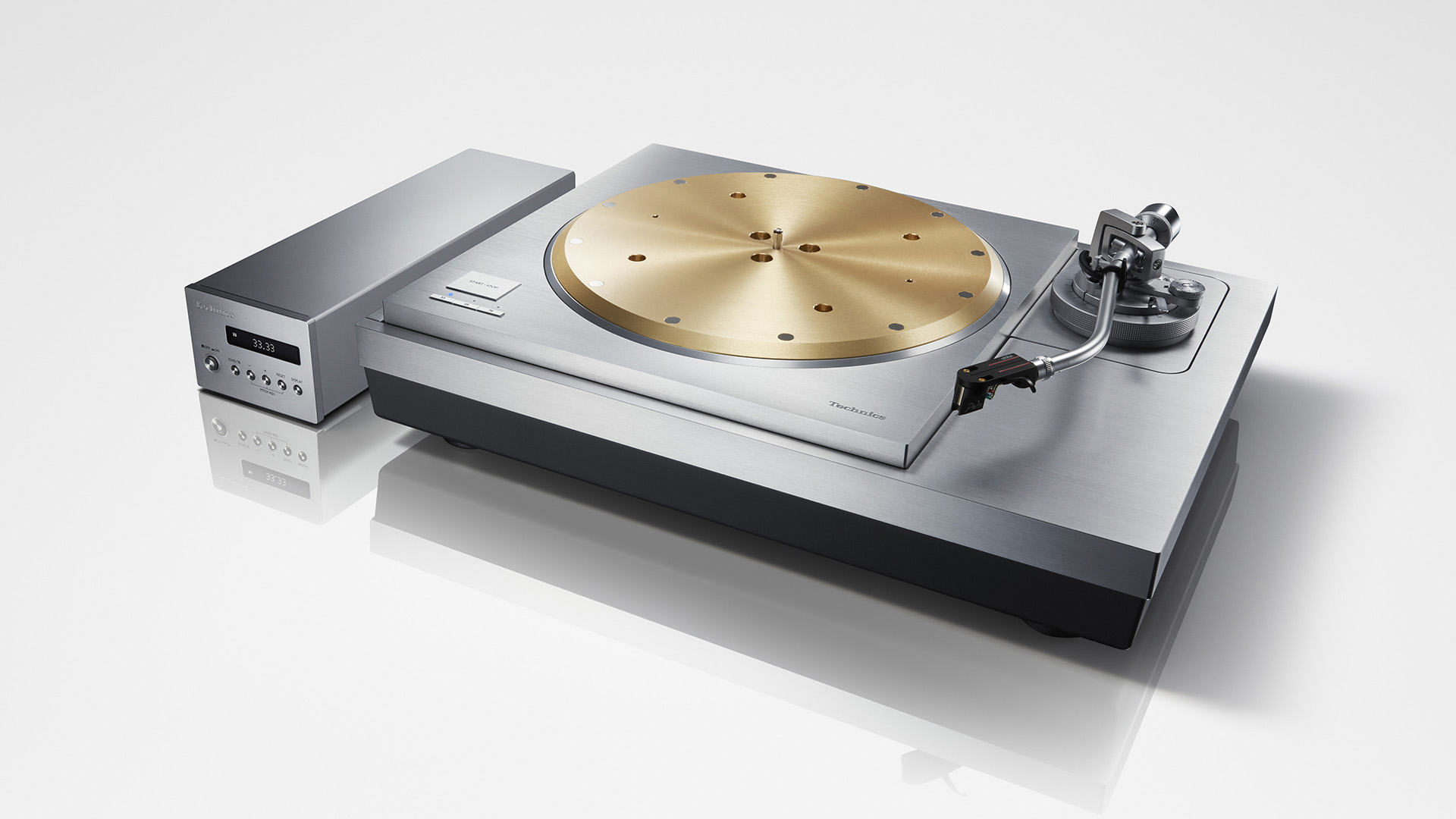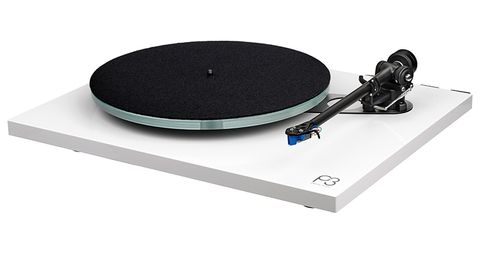Technics was founded in 1965 as Panasonic Corporation’s high-end hi-fi brand. The term first appeared on loudspeakers, but it was an obvious fit for Shuichi Obata’s innovative transcription turntable. The ‘Technics by Panasonic’ SP-10 was the world’s first direct drive deck of the contemporary era, debuting in 1970. It made its way into broadcast studios all around the world, displacing Garrard 301s. It was super speed steady (0.03 percent wow and flutter) and could get up to 33.33RPM within half a revolution of the platter, in addition to having vanishingly low rumble (a reported -70dB, DIN B).
In 1975, the SP-10 Mk2 was released, this time with the SH-10E outboard power supply unit. The SL-1000, a consumer version with a bundled Technics tonearm, was released. The new SH-10B3 Obsidian Base for the deck is composed of volcanic glass, no less! The SP-10 Mk3 debuted in 1981, with a copper alloy/aluminum platter and a restyled speed control mechanism with adjustable pitch of +/- 9%. However, as Compact Disc became more popular in the mid-eighties, sales began to drop. Nonetheless, collectors flocked to these early Technics reference decks, and by the end of the first decade of the new millennium, they were in high demand on the secondary market.
Around this time, Technics stopped producing the SL-1200, which appeared to be the company’s last turntable. Tetsuya Itani, the company’s Chief Technical Officer, explained that this was due to worn-out manufacturing machinery. It also happened to coincide with the credit crunch, when major luxury businesses were cutting back. Despite a massive campaign calling for its reintroduction, the SL-1200G was resurrected in 2016, upgraded and more expensive. At the same time, Technics was about to release the SP-10R, its new flagship broadcast turntable. The package was dubbed the Reference Class SL-1000R when it was delivered in its custom base and with Technics’ new tonearm.
In 2018, Itani told me, “I think we can reveal the sonic direction of the upcoming generation of direct drive turntables – one that is significantly distinct from the sound of belt drives.” “I wanted to demonstrate the enhanced sound of a deck with as low resonance as possible using the SL-1000R. That’s why, rather of the hefty wooden kind found on the previous SL-1000, I utilized the smallest feasible plinth – constructed of aluminium and BMC.” The sound is “extremely precise but warm, with a great signal-to-noise ratio,” he says. “In my perspective, no belt drive turntable can deliver this,” Itani san says.
It took a year for Itani’s ten engineers to complete this new £14,000 turntable kit. It was a completely new design from the ground up, rather than a refresh of the existing SP-10 mk3. The innovative coreless direct drive motor, first developed for the SL-1200G and refined for this purpose, is at its heart. It’s a coreless, double coil double rotor design with coils on both sides for a 12-pole, 18-coil drive that delivers immense torque; on the highest of five user-selectable settings, you’d have to put a lot of pressure on the rim of the 7.9kg platter to slow it down at all. Technics claims a wow and flutter of 0.015 percent, which is close to the measurement’s limit. The 10mm thick brass weights fitted into the periphery of the diecast aluminium platter give it a reported inertial mass of 1 ton/cm. A rubber dampening material is used underneath, and a rubber mat is placed on top.
The control device has an OLED digital display that shows the speed (33 1/3 RPM, 45, and 78 RPM), as well as the chosen playing speed expressed as a percentage (i.e. 45.11 percent when the pitch is increased) and actual RPM (i.e. 33.33). The speed of rotation is specified to two decimal places, plus or minus 16 percent. The torque control menu is accessed by pressing the speed up/down and reset buttons on the control unit. “Some users appreciate this facility to tune the sound,” Itani says. It has an effect on this as well as the start-up speed, but it has no effect on speed stability.” The control unit, which also houses the deck’s switch mode power supply, was planned to have the same size as previous SP-10 control units.
The redesigned motor unit’s chassis, according to Technics, is more rigid than previous generations, with a better main bearing arrangement. Thanks to two large stainless steel weights at the bottom of the chassis, the motor is stabilized with a low center of gravity. The top panel is 25mm aluminium, the main portion is diecast aluminium, and the compound is Technics Bulk Molding Compound. It is supported by a two-layer plinth with a 30mm aluminium top plate and a BMC base. The feet include a zinc diecast exterior part with silicon rubber within and cylindrical polymer tubes for reinforcement. The motor unit of the SP-10R is designed to slot directly into the SP-10MK2 and SP-10MK3 plinth systems, allowing users of these decks to upgrade. The deck may accommodate up to two additional tonearm bases for a variety of arms, which are installed via concealed panels in the plinth’s side. The SL-1000R is a huge 40.2kg even with just one.
The tonearm has been given careful consideration by the design team, despite the fact that it is not the package’s main feature. It’s a universal S-shaped type with a 254mm (10 inch) effective length from the tonearm pivot to the stylus, which is longer than the one on the SL-1200G. It has a finely crafted lightweight magnesium tube with precision bearings and gimbal suspension. This is believed to have been hand-assembled and adjusted, with oxygen-free copper wiring installed within. The counterweight and bias adjusters have a measured, high precision action, and the base has an attractive system for height adjustment (0-15mm). Auxiliary balancing weights are included, ranging from 15.9 to 31g. The deck is easy to use, thanks to its broad, strong foundation, which makes hand cueing a breeze. The tonearm is silky smooth, and the motor unit is stunning to watch in action, but the control box can be cumbersome to use if you want to access sub-menus like the torque setting, for example.
The SL-1000R provides a wide open window on the recording, stepping back to allow the listener to hear exactly what’s going on for themselves. The music bubbles up from the groove, creating a delightfully zesty sound that is rich in detail. There appear to be enormous, open spaces between each beat, allowing you to focus on minute parts of the production while still listening to the entire song flow in a pleasantly lucid manner. The Technics is one of the few high-end turntables that can do this trick that I’ve heard. Listening to music from it is like hopping on a train; there’s only one way to go while you sit and watch the scenery pass you by, but you may focus on all sorts of strange and amazing aspects as you speed past.
The SL-1000R cannot be described as “one of those analytical Japanese direct drives” due to its superb rhythmic abilities, which provides for an exhilarating listen. Whatever it is asked to play, it does it with zeal. Its combination of clarity, timing, and dynamics is so impressive that it makes you wonder what the point of high-end digital audio is. It never ceases to surprise me how this vinyl-spinner can extract both subtle accenting and tremendous dynamic differences from mediocre vinyl pressings. You sit fascinated as all of the recording’s sophisticated stages of production unfold themselves before your very ears, thanks to dynamic light and shade.
The deck’s ability to handle frequency extremes is also impressive. Because it has the capacity to begin and end bass notes with the pace of an LED pulsating on and off, those who have grown up with warmer, gentler belt drive turntables may initially assume the SL-1000R sounds a little ‘digital’ at the bottom end. Hi-hat cymbals have great timbral delicacy, shimmering like stars glinting out of the night sky. Bass guitar lines sound lightning-fast and very expressive, while hi-hat cymbals have tremendous timbral delicacy, shimmering like stars glinting out of the night sky.
This is a fantastic turntable kit, and one of the best methods to listen to vinyl ever created – as it should be at this price point. The SP-10R motor unit is impossible to improve upon, and the accompanying base and tonearm are both of excellent quality. The Technics SL-1000R is a towering statement of engineering brilliance that ushers direct drive back into the top echelon of turntables.







